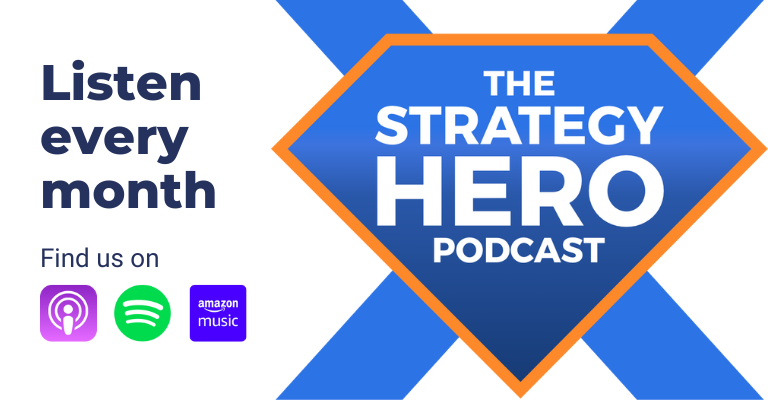How do you set strategic priorities? We found the answer and much more in season two, episode two of the Strategy Hero podcast with Kit Jackson. Here's what I took from my time with her.
As we create the list of guests for the Strategy Hero podcast, we're looking for a blend of insights you can put into action, some more theoretical subjects, and then that personal element that turns your head.
I found that from the time I spent with strategy mapping expert, Kit Jackson, as she showed us the personal side of strategy. Here's what I learned.
It’s important to note that my opinions do not reflect those of i-nexus or Kit Jackson.
Enjoy!
Putting the person into strategy
I gravitate to people who think about the person behind everything.
No action is made without that person. No thought. No purpose.
Kit Jackson is one of those people.
As we started our episode, she opened up about the very personal story that sat behind the earliest days of her career, and, ultimately what led her to discover Norton and Kaplan's balanced scorecard.
Fitting was the timing of the episode given the importance of the balanced scorecard to Kit. Recording days after the passing of David Norton, Kit showed that the brightest and most innovative people are able to take a concept from one lane in their lives and use it to see another from a different angle.
That is what Kit Jackson does. She takes the concept of a map, like the balanced scorecard, and uses it as a way to map her client's personal life.
Her goal, as she said, is simple. To help people:
"Make better strategic choices in the present."
Being present and strategic
There's a lot to say about how being a strategic thinker can create a disconnect with reality.
We all know the line about the ivory tower of leaders who disappear to an exotic resort alongside a consulting firm to "create a strategy."
Kit challenges that idea. She believes that we can be strategic and present in the moment. When you look at episodes like the 4Cs of Hoshin Kanri, we can see this topic rear its head throughout this series.
That is where a strategy map comes in. It is built to help you generate the skills, clarity, and path to being someone present in the moment and strategic. For Kit, it's the map that helps her to adapt to the challenges that come in both business and personal life - shaping direction as challenges appear.
"I've always wanted to make a difference in people's lives."
Homeward Bound
Kit's driven by making a difference. That's not always a difference in revenue or efficiencies, it is best seen in her work with Homeward Bound, the female and minorities-focused leadership community.
It's fantastic to see someone with the career (and influence) of Kit looking to make a difference. The community, as she explained, focuses on helping the marginalized get to the front of businesses and make a lasting impact - as leaders and mentors.
When we first met, Kit was preparing for another trip with the community. This trip would put her and the groups face to face with natural adversity, creating a perfect environment to be strategic and present.
That gets to the root of Kit's goal - to make strategy pragmatic, clear, and a framework for forming better choices.
Kit embodies why we call our guests heroes.
"Values, you don't choose them, they choose you."
Values guiding strategic priorities
Kit made a great point about values. Not just the quote above, but the fact that our values guide all that we are. If we want to make a change in our lives, that is led by what is inside us.
The same can be said with strategy execution. The very creation of a strategy is the coming together of different values, perspectives, and ideas. And, even if you don't know where you're heading (the strategy), understanding your values will always act as your starting point.
Just as values help you to set strategy, they're there when you're prioritizing your work. They're there when you speak to customers, colleagues, friends, and family.
But these values must feed culture.
“We value busy-ness and we're uncomfortable with the uncertainty of reflection, so we'll fill our day with the insignificant."
The "and, and, and" culture
We all know the scenario that Kit unveils.
We set a strategy, the plan and projects follow, and from there it builds.
That snowball is the "and, and, and" culture. It's the feeling that success is impossible as your plate overflows.
Kit explains that this, in her eyes, comes from your strategic priorities and two scenarios:
1) You haven't set the strategic priorities
Here, you've created all the above, but nothing is guiding your strategic priorities. You, as a leader, haven't explicitly said what will happen in different scenarios based on your priorities. Scenario planning is flawed.
2) Strategic priorities haven't been communicated
If your strategic priorities have been set, you've yet to pass these around your teams.
In both, no one knows the meaning of these priorities. You must explain what your strategic priorities mean, the values behind them, the behaviors that exemplify them, and how they'll be introduced to feed decision-making.
It takes time and effort to do strategy well. Too often we set it and then face the end of the year, wondering either how we can justify future investment or look to invest in other efforts, benefits never to be seen.
Be sure to consistently review your strategy, ready to adapt. You can only do that by eliminating the "and, and, and" culture.
My takeaway
Being personal in strategy means finding your values as a team and using these to set priorities.
However, it is up to leadership to model the behaviors that bring these values to life and ensure strategic priorities can be considered during decision-making.
That means leaders must create the space to enable strategic thinking in the moment. That's regular sessions to talk about strategy. That's ensuring your decisions link back to your values. It's recognizing the value of strategic thinking, seeking input, and enabling the sharing of thoughts, ideas, and concerns.
Enabling your team to tackle the ever-changing challenges you'll face starts and ends with a personal strategy.
Thanks for being our second hero of the season, Kit!
Listen to the episode
Kit's episode was the second of season two of Strategy Hero.
You can click here to listen to Kit's episode, search "Strategy Hero" wherever you find your favorite podcasts, or click the play button below.
About Strategy Hero
Published on the last Thursday of every month, the Strategy Hero podcast delves into the world of business strategy and transformation.
Each cast shines a spotlight on a Strategy Hero – inspirers, boundary pushers, and leaders of change from all walks of life – armed with practical advice on achieving your goals.
Episodes explore topics around operational excellence, Lean management, process improvement, change management, and much, much more. Available where all great podcasts live, listen on-demand today, and discover the Strategy Hero inside you.
About the host
James Milsom is Head of Marketing at i-nexus, but James is a storyteller. He’s the UK’s biggest Georgia Bulldogs fan (Go Dawgs!) and lives and breathes marketing.
The Strategy Hero podcast is his opportunity to bring some of his conversations with mentors, inspirers, and people anew to you every month.
He’s behind the content read and watched by people like you and lives to educate and help others.
If you’d like to learn more about him, connect with him on LinkedIn and subscribe to the Strategy Hero podcast today!



.jpg?width=352&name=KPIs%20(3).jpg)